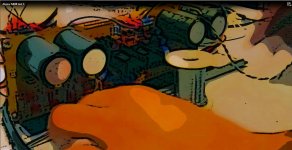That is a good idea, then this coil is double isolatedI put heat-shrink tubing around mine. It seems to be working well.

Regards,
Rudy
My air core inductor is just a spring, how I get this firmly with glue?
Regards,
Rudy
That gauge of wire should be rigid enough to simply run down the length with superglue in a couple of places, if close coupled. That’s what I do. Doesn’t seem to affect the enamel coating.
Oh, and your coil is 1000 times too small, according to the silk screen on the board (2.2mH)
Brian.
I have used a thick wire...this way it turns very strong
and stay in place even if you hit it with a hammer.
I have drilled larger holes to the coil, and the pad, the island to solder was increased in size scratching using a knife..the a lot of solder keep the thing in place.... yeah.... a little bit exagerated.
This coil is "just in case".... in normal use it does nothing.... we can even use a wire jumper in it's place in most of the cases.... because of that...it is not that critical, the number of turns and diameter can be different.
In some amplifiers we use to correct overshots...not in this amplifier...it is stable.... if no broadcasting station is transmitting nearby the amplifier or speaker cables, then it will not face troubles...if cables are not too much high in capacitance and length then no problems too...if speaker crossover is not that crazy...then everything gonna be all right.... in other words, in "normal set up", you will not need the coil.
There's a lot of thinks we include in audio amplifiers "just in case".... analogy is the air bag...they are included in your cars "just in case".... normally they will not be used.... these things are there for care, for caution.
Bypass capacitors are there for the same reason... they will operate stopping oscillations..but only if oscillations starts... not having rail instabilities or transistors going unstable, then these parts will not work.... also zobel filter is another case, the input RF capacitor is one more... rail condensers and so on.
In other words...if you coil has thick wires or thin wires... there's no problems about
If coil turns is smaller or bigger..then no troubles
Unstable amplifiers needs more care than this one...this is a Blameless with make up, from Doctor Self.... the man!
regards,
Carlos
and stay in place even if you hit it with a hammer.
I have drilled larger holes to the coil, and the pad, the island to solder was increased in size scratching using a knife..the a lot of solder keep the thing in place.... yeah.... a little bit exagerated.
This coil is "just in case".... in normal use it does nothing.... we can even use a wire jumper in it's place in most of the cases.... because of that...it is not that critical, the number of turns and diameter can be different.
In some amplifiers we use to correct overshots...not in this amplifier...it is stable.... if no broadcasting station is transmitting nearby the amplifier or speaker cables, then it will not face troubles...if cables are not too much high in capacitance and length then no problems too...if speaker crossover is not that crazy...then everything gonna be all right.... in other words, in "normal set up", you will not need the coil.
There's a lot of thinks we include in audio amplifiers "just in case".... analogy is the air bag...they are included in your cars "just in case".... normally they will not be used.... these things are there for care, for caution.
Bypass capacitors are there for the same reason... they will operate stopping oscillations..but only if oscillations starts... not having rail instabilities or transistors going unstable, then these parts will not work.... also zobel filter is another case, the input RF capacitor is one more... rail condensers and so on.
In other words...if you coil has thick wires or thin wires... there's no problems about
If coil turns is smaller or bigger..then no troubles
Unstable amplifiers needs more care than this one...this is a Blameless with make up, from Doctor Self.... the man!
regards,
Carlos
Attachments
Last edited:
Dear Pingrs.... this 2.2uh is not something deeply studied and calculated
I am not able to re invent the powder without smoke...these things are validated in the daily practice...everybody uses 2.2uH.... 9 in 10 amplifiers use this value...was proven that work fine in most of the cases.....i made the choice copying what Self did and others did... a little bit more or less will not harm the amplifier operation... audio amplifiers use to have tolerances... the supply has more or less 10 percent... resistors are 5 percent or 1 percent, condensers can operate in 30 percent more voltage and transistors can be substituted by several other types...there's not all that precision we think.
You can change if you want and if you need, in special based in the fact that is there "just in case"..... so, we never know if the "case" is a bigger case or small case...we do not know what is the case or it's size.
You know...i am not that different that others...i bother myself to tweak the amplifier to read 0.003% THD..... a foolish as when we connect the speakers the distortion they produce is in the order of 2 to 5 percent to the better ones...so... my concerns are something like blowing in the wind.
This is the most wonderful thing in analog amplifiers... is that they are not that precise..we can make mistakes.
Critical are differential current, VAS topology and VAS current, output topology and output stand by current, Miller capacitor value and your choices how to feed the stages, bootstrap?... CCS?... mirrors?... these things changes performance...small modifications within rational tolerances does not bother the audio amplifier overall performance..will not be the output coil value that will increase of decrease the audio quality in a stable system (without terrible errors described in earlier posts)
regards,
Carlos
I am not able to re invent the powder without smoke...these things are validated in the daily practice...everybody uses 2.2uH.... 9 in 10 amplifiers use this value...was proven that work fine in most of the cases.....i made the choice copying what Self did and others did... a little bit more or less will not harm the amplifier operation... audio amplifiers use to have tolerances... the supply has more or less 10 percent... resistors are 5 percent or 1 percent, condensers can operate in 30 percent more voltage and transistors can be substituted by several other types...there's not all that precision we think.
You can change if you want and if you need, in special based in the fact that is there "just in case"..... so, we never know if the "case" is a bigger case or small case...we do not know what is the case or it's size.
You know...i am not that different that others...i bother myself to tweak the amplifier to read 0.003% THD..... a foolish as when we connect the speakers the distortion they produce is in the order of 2 to 5 percent to the better ones...so... my concerns are something like blowing in the wind.
This is the most wonderful thing in analog amplifiers... is that they are not that precise..we can make mistakes.
Critical are differential current, VAS topology and VAS current, output topology and output stand by current, Miller capacitor value and your choices how to feed the stages, bootstrap?... CCS?... mirrors?... these things changes performance...small modifications within rational tolerances does not bother the audio amplifier overall performance..will not be the output coil value that will increase of decrease the audio quality in a stable system (without terrible errors described in earlier posts)
regards,
Carlos
Last edited:
The L of the output R//L is definitely not 2 to 3mH, no matter what anyone shows in BOMs nor on PCBs.
1uH is normally a good guide, but DX recommends higher than this.
I tend to use a 15mm diameter mandrel and wind on 8T to 12T of 1.2mm or 1.4mm diameter enameled copper wire. If I wanted low milli-ohms and non vibrating I would use 1.6mm diam wire and wind 3 layers, each with 3T, for a total of 9T. Bind it with some strong sewing thread. Then soak it in three applications of nail varnish.
1uH is normally a good guide, but DX recommends higher than this.
I tend to use a 15mm diameter mandrel and wind on 8T to 12T of 1.2mm or 1.4mm diameter enameled copper wire. If I wanted low milli-ohms and non vibrating I would use 1.6mm diam wire and wind 3 layers, each with 3T, for a total of 9T. Bind it with some strong sewing thread. Then soak it in three applications of nail varnish.
questions
Hello,
I'm interested in this amp, but have a few simple new guy questions:
Thanks,
Mason
Hello,
I'm interested in this amp, but have a few simple new guy questions:
- How many channels does the DX Blame MKIII Hx (Supercharged) put out? From the PCB it looks like one or two?
- What is the allowable DC input (+/-) voltage, and associated power into an 8 ohm load?
- What is the difference between the DX Blame ES, ST, MKII, Supercharged?
Thanks,
Mason
Dx Blame ES, Blame ST and Supercharged MKII is subject of other threads
This thread you are was made to talk about MKIII (three) Hx ... or MKIII Hx
Dc Blame ES
Dx Blame ST
Dx Blame MKII
Dx Blame MKII Supercharged
These ones constitutes four models served by the same board...there are instructions and charts to instruct you about what parts should be replaced to assemble each one of these 4 different models, all them can be built using the same pcboard...the pcboard is good to all 4 models....there are codified parts using part numbers (R1, C2 and so on) and these ones are interchangeable parts... they are specific parts that corresponds to different values in accordance to each specific amplifier you select to assemble....all other parts are standard and the value is printed into the pcboard layout silk screen.
About power of each amplifier, specifications and overall performance, you should read Dx Blame ES and Dx Blame ST thread (both amplifiers in the same thread)...and developments are in this same thread...you should search for MKII Supercharged using forum search button and you should read them all to know more details about.
These amplifiers ( Dx Blame ES, Dx Blame ST, Dx Blame MKII, Dx Blame MKII Supercharged) are previous models,they are not the last ones...they were the base to evolute..the reference..they sound excellent too. .... the MKIII Hx is the evolution of these previous models..these ones, the Blame series, was created, built, tested, a pcboard layout was made, a board was manufactured, a board was assembled and tested, we had group buy, several boards where sold at cost price inside group buy...people have assembled, and now we are in a more modern unit while many guys are still listening and enjoying the Blame series (Dx Blame ES, Dx Blame ST, Dx Blame MKII and Dx Blame MKII Supercharged)... the we had the MKIII and MKIII Hx that is the subject of this thread we are now producing off topic (against rules...here is to talk about MKIII Hx only)
You should read some...to know what happened in this forum these last years...i have readed this forum (all forum, entire solid state section...since the beginning) and i did that four times...you should, at least, search for threads with these names i have informed and read them all prior to post questions.
Here you have what you need:
*
Please visit and open all files in the Kinghost...read instructions, if something is not clear or missed, then try forum search button or send messages to:
nanabrother@hotmail.com
There's no boards for sale...you have to etch your own board.
Please take some time to read in advance to post questions...we have worked a lot to write instructions in the diyaudio to avoid us to be repeating to each new member that arrive.... and all this work was made to serve you and all beginners that are giving us the pleasure to be interested in the Dx Corporation amplifiers (not a real business, it is a union of the best wide world audiophiles only)
regards,
Carlos
This thread you are was made to talk about MKIII (three) Hx ... or MKIII Hx
Dc Blame ES
Dx Blame ST
Dx Blame MKII
Dx Blame MKII Supercharged
These ones constitutes four models served by the same board...there are instructions and charts to instruct you about what parts should be replaced to assemble each one of these 4 different models, all them can be built using the same pcboard...the pcboard is good to all 4 models....there are codified parts using part numbers (R1, C2 and so on) and these ones are interchangeable parts... they are specific parts that corresponds to different values in accordance to each specific amplifier you select to assemble....all other parts are standard and the value is printed into the pcboard layout silk screen.
About power of each amplifier, specifications and overall performance, you should read Dx Blame ES and Dx Blame ST thread (both amplifiers in the same thread)...and developments are in this same thread...you should search for MKII Supercharged using forum search button and you should read them all to know more details about.
These amplifiers ( Dx Blame ES, Dx Blame ST, Dx Blame MKII, Dx Blame MKII Supercharged) are previous models,they are not the last ones...they were the base to evolute..the reference..they sound excellent too. .... the MKIII Hx is the evolution of these previous models..these ones, the Blame series, was created, built, tested, a pcboard layout was made, a board was manufactured, a board was assembled and tested, we had group buy, several boards where sold at cost price inside group buy...people have assembled, and now we are in a more modern unit while many guys are still listening and enjoying the Blame series (Dx Blame ES, Dx Blame ST, Dx Blame MKII and Dx Blame MKII Supercharged)... the we had the MKIII and MKIII Hx that is the subject of this thread we are now producing off topic (against rules...here is to talk about MKIII Hx only)
You should read some...to know what happened in this forum these last years...i have readed this forum (all forum, entire solid state section...since the beginning) and i did that four times...you should, at least, search for threads with these names i have informed and read them all prior to post questions.
Here you have what you need:
*
Please visit and open all files in the Kinghost...read instructions, if something is not clear or missed, then try forum search button or send messages to:
nanabrother@hotmail.com
There's no boards for sale...you have to etch your own board.
Please take some time to read in advance to post questions...we have worked a lot to write instructions in the diyaudio to avoid us to be repeating to each new member that arrive.... and all this work was made to serve you and all beginners that are giving us the pleasure to be interested in the Dx Corporation amplifiers (not a real business, it is a union of the best wide world audiophiles only)
regards,
Carlos
Last edited:
Carlos,
Thanks for the explanation; that answers quite a few of my questions. I will have to investigate the other forum posts, although there's quite a lot of information to sort through. It would be great if someone familiar with the project could write an updated Wiki or guide.
/Mason
Please take some time to read in advance to post questions...we have worked a lot to write instructions in the diyaudio to avoid us to be repeating to each new member that arrive.... and all this work was made to serve you and all beginners that are giving us the pleasure to be interested in the Dx Corporation amplifiers (not a real business, it is a union of the best wide world audiophiles only)
Thanks for the explanation; that answers quite a few of my questions. I will have to investigate the other forum posts, although there's quite a lot of information to sort through. It would be great if someone familiar with the project could write an updated Wiki or guide.
/Mason
Finally second board done!
Hey guys!
Finally the second board is completed, is a bit different from the other because I decide to place the 1N4007 diode to the bottom of the board I don't think that can be bad also like mister Carlos said to change the 22ohms resistor to 47ohm is done for both boards I'm going to test the second board tomorrow is kind of late but yeah I'm happy that is completed, I have to wash the bottom of the board with some soap to clean all the flux residues and be ready to test, I use some hot gun glue to keep the caps steady not really necessary but is for myself so is all good.
About the chassis for the amp I have problems with the shipping not many web sites send stuff to Puerto Rico so if some one know a good web site that sales amplifier chassis please let me know I do appreciate any information guys, al right guys "Merry Christmas to all of you MKIII Hx builders"!
Regards
vargasmongo3435
Hey guys!
Finally the second board is completed, is a bit different from the other because I decide to place the 1N4007 diode to the bottom of the board I don't think that can be bad also like mister Carlos said to change the 22ohms resistor to 47ohm is done for both boards I'm going to test the second board tomorrow is kind of late but yeah I'm happy that is completed, I have to wash the bottom of the board with some soap to clean all the flux residues and be ready to test, I use some hot gun glue to keep the caps steady not really necessary but is for myself so is all good.
About the chassis for the amp I have problems with the shipping not many web sites send stuff to Puerto Rico so if some one know a good web site that sales amplifier chassis please let me know I do appreciate any information guys, al right guys "Merry Christmas to all of you MKIII Hx builders"!
Regards
vargasmongo3435
Attachments
Now you have a stereo.... very good Juan
I use Kerosene (aviation jet fuel) to remove flux from my circuit board.
Alcohol also works, but let some white powder in the place where have removed the flux and forces you to complete the job using kerosene or other paint solvent..... soap helps too...but not all that good.
Old tooth brush and Kerosene is perfect...let it evaporate by itself and enjoy the good look of your circuit board.
Cachaça, Whisky, Tequila and some hot beverages also help.
Alcohol and other things alike.... Ethanol, Etilic, Isopropyl and all variations
regards,
Carlos
I use Kerosene (aviation jet fuel) to remove flux from my circuit board.
Alcohol also works, but let some white powder in the place where have removed the flux and forces you to complete the job using kerosene or other paint solvent..... soap helps too...but not all that good.
Old tooth brush and Kerosene is perfect...let it evaporate by itself and enjoy the good look of your circuit board.
Cachaça, Whisky, Tequila and some hot beverages also help.
Alcohol and other things alike.... Ethanol, Etilic, Isopropyl and all variations
regards,
Carlos
Attachments
Last edited:
Almost all paint solvent will do the job
all these liquids we use to dilute paint...and to clean our hands and brushes.
Petrol solvents
Thinner cannot be used, also acetone can remove old board's silk screen... gasoline can be use but have bad smell.
Brazilian gasoline does the job perfectly because already has 20 percent of Alcohol mixed into it...a different kind of alcohol that does not contain water in it's formula (anhydrous)... you must come here and i will give you some .
.
regards,
Carlos
all these liquids we use to dilute paint...and to clean our hands and brushes.
Petrol solvents
Thinner cannot be used, also acetone can remove old board's silk screen... gasoline can be use but have bad smell.
Brazilian gasoline does the job perfectly because already has 20 percent of Alcohol mixed into it...a different kind of alcohol that does not contain water in it's formula (anhydrous)... you must come here and i will give you some
regards,
Carlos
Last edited:
- Status
- Not open for further replies.
- Home
- Amplifiers
- Solid State
- Dx Blame MKIII-Hx - Builder's thread
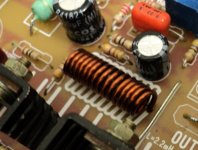
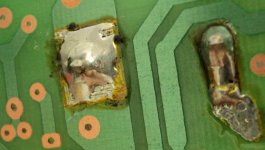
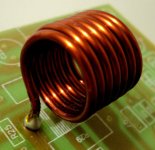
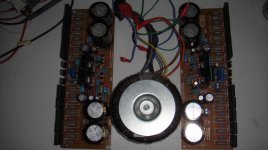
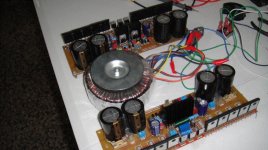
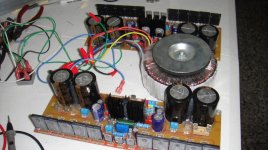
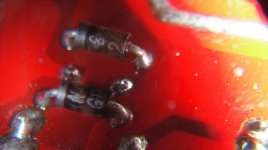
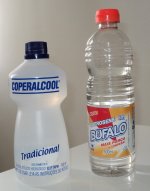
 lol jabon
lol jabon 
